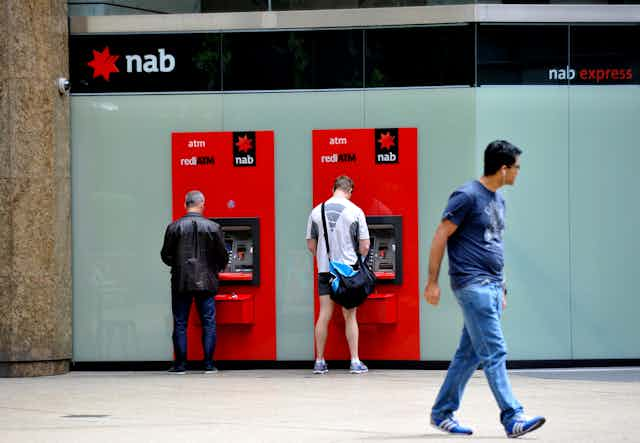As the Automatic Teller Machine (ATM) celebrates its 50th birthday, it’s actually being used less and less to withdraw cash in Australia. There are currently more than 32,000 ATMs across Australia and cash withdrawals in February 2017 were A$9,924 million, down 10% from the previous year and just above the total of February 2005.
ATM’s (Automatic Teller Machines) were first introduced at the end of June 1967 and were welcomed by both bank customers and the banks themselves. This “hole in the wall” enabled customers to access their cash 24/7. The ATM’s self-service nature enabled the banks to reduce their costs, by closing bank branches, reducing opening hours and laying off staff.
But the Reserve Bank of Australia’s 2016 Consumer Payments Survey reported that cards were used more often than cash for in-person payments, as well as online payments. This is facilitated by Australian consumers and merchants’ rapid adoption of contactless.
The July 2017 changes to the level of merchant service fees for accepting payment cards might even further reduce our reliance on these machines. The changes should reduce surcharging and minimum spends for accepting cards (in theory) and we will then have even less reason to carry cash.
ATMs will need to evolve to remain relevant, perhaps taking on other services entirely.
Lots of cash, just not from ATMs
Paradoxically, there has never been so much cash available in Australia. By April 2017 there were 1.5 billion individual banknotes on issue, an average of 62 notes for every Australian. The RBA has recently opened a new super bank vault to store its contingency reserves of banknotes.
There are similar patterns in other countries. For example, the Bank of England notes in circulation rose by 10% in 2016, the fastest pace in a decade. This is despite technological advances that now allow people to pay by contactless cards and digital devices, such as mobile phones.
Why then is cash still so popular? The RBA’s 2016 survey concluded that cash is widely held as a store of value. If found 70% of respondents to the survey held cash in places other than their purses and wallets.
The government’s Black Economy Taskforce estimates that the Australian black economy is around 1.5% of GDP, or A$25 billion per year. Much of this is enabled by the use of hard cash, as opposed to electronic payments.
Harvard professor Kenneth Rogoff wrote that physical cash can facilitate corruption and tax evasion. In his view, many of the disadvantages of cash could be reduced if larger denomination notes were withdrawn from circulation.
As an example, the Euro 500 note is due to be withdrawn from the end of 2018, however it may take more than this to reduce the underlying attraction of cash.
There are many assumptions, attitudes and beliefs which legitimise and perpetuate participation in the black economy. Questioning these will require behavioural change from all citizens, according to the Black Economy Taskforce’s interim report. As an example, if someone else is avoiding GST by paying in cash, others might think “well if they are doing it, I would be a fool not to do it myself”.
Other uses for the ATM
These are services available to bank customers through their ATMs in countries other than Australia. For example, ATMs could be made more efficient by encouraging more customers to deposit cash into the ATM and then recycling that cash in the machine to be used by those seeking to withdraw cash. This would remove many of the costs and security risks of constantly replenishing ATMs with cash.
Additional functions could be added to the ATM. In the United States you can buy postage stamps at the ATM; in Spain tickets to football matches; in Dubai bars of gold; in California fresh cupcakes and elsewhere fishing licenses and tax bills can all be accessed through ATMs.
As regards customer security to ward off identity theft, biometric measures could make access to the ATM more secure. In Japan finger vein scanning is already in use in many ATMs.
These developments could put ATMs in the forefront of an enhanced customer experience, giving the ATM reasons to survive for another 50 years.

